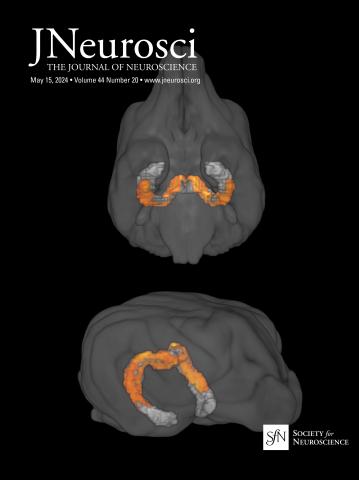纹状体多巴胺组胺调节的性别差异。
IF 4.4
2区 医学
Q1 NEUROSCIENCES
引用次数: 0
摘要
多巴胺对基底神经节的调节在男性和女性中是不同的,这与许多神经精神疾病有关,包括一些在患病率上有明显性别差异的疾病,比如图雷特综合症(TS)和注意缺陷多动障碍(ADHD)。TS的遗传研究和随后的动物研究表明,组胺的缺失可能导致多巴胺的失调。基于此,我们利用微透析、靶向药理学和shRNA敲低组胺受体的方法,描述了组胺对纹状体多巴胺的调节。脑室内(ICV)组胺减少雄性小鼠纹状体多巴胺,重复先前的工作。相反,出乎意料的是,ICV组胺增加了雌性纹状体多巴胺。ICV或靶向输注激动剂表明,雄性的作用取决于黑质致密部(SNc)的H2R受体。在SNc gaba能神经元中,H2R的敲除消除了这种效应,确定这些细胞是组胺调节雄性多巴胺的关键位点。然而,在女性中,H2R没有明显的作用;相反,纹状体中的H3R激动剂增加了纹状体多巴胺。引人注目的是,组胺对雌性多巴胺的影响是由发情周期调节的,只出现在发情/发情前期,这时雌性激素水平很高。这些发现证实了组胺对纹状体多巴胺的调节,但确定了这种作用的显着性别差异和发情调节。这些发现可能揭示纹状体回路和几种神经精神疾病中性别差异的机制基础。基底神经节的失调有助于许多神经精神疾病的病理生理,包括一些以性别差异为特征的图雷特综合征(TS)。先前的人类遗传研究确定组胺失调是TS发展的潜在因素;小鼠的后续研究强调了组胺在调节纹状体多巴胺张力中的作用。纹状体多巴胺失调与许多神经精神疾病有关,包括TS、精神分裂症和注意缺陷多动障碍。在这里,我们发现新的和显著的性别差异在组胺调节纹状体的多巴胺能调节。更好地了解这些差异可能有助于深入了解神经精神疾病中性别依赖结果的潜在机制。本文章由计算机程序翻译,如有差异,请以英文原文为准。
Sex differences in histamine regulation of striatal dopamine.
Dopamine modulation of the basal ganglia differs in males and females and is implicated in numerous neuropsychiatric conditions, including some, like Tourette Syndrome (TS) and attention deficit hyperactivity disorder (ADHD), that have marked sex differences in prevalence. Genetic studies in TS and subsequent work in animals suggest that a loss of histamine may contribute to dysregulation of dopamine. Motivated by this, we characterized the modulation of striatal dopamine by histamine, using microdialysis, targeted pharmacology, and shRNA knockdown of histamine receptors. Intracerebroventricular (ICV) histamine reduced striatal dopamine in male mice, replicating previous work. In contrast, and unexpectedly, ICV histamine increased striatal dopamine in females. ICV or targeted infusion of agonists revealed that the effect in males depends on H2R receptors in the substantia nigra pars compacta (SNc). Knockdown of H2R in SNc GABAergic neurons abrogated the effect, identifying these cells as a key locus of histamine's regulation of dopamine in males. In females, however, H2R had no discernible role; instead, H3R agonists in the striatum increased striatal dopamine. Strikingly, the effect of histamine on dopamine in females was modulated by the estrous cycle, appearing only in estrus/proestrus, when estrogen levels are high. These findings confirm the regulation of striatal dopamine by histamine but identify marked sexual differences in and estrous modulation of this effect. These findings may shed light on the mechanistic underpinnings of sex differences in the striatal circuitry, and in several neuropsychiatric conditions.Significance Statement Dysregulation of the basal ganglia contributes to the pathophysiology of numerous neuropsychiatric diseases, including several, such as Tourette syndrome (TS), that are characterized by sex differences. Previous genetic studies in humans identified histamine dysregulation as a potential to the development of TS; follow-up work in mice highlighted the role of histamine in regulating striatal dopamine tone. Striatal dopamine dysregulation has been implicated in numerous neuropsychiatric disorders, including TS, schizophrenia, and attention deficit-hyperactivity disorder. Here, we uncover novel and significant sex differences in histamine regulation of dopaminergic modulation of the striatum. A better understanding of these differences may provide insight into the mechanisms underlying sex-dependent outcomes in neuropsychiatric disease.
求助全文
通过发布文献求助,成功后即可免费获取论文全文。
去求助
来源期刊

Journal of Neuroscience
医学-神经科学
CiteScore
9.30
自引率
3.80%
发文量
1164
审稿时长
12 months
期刊介绍:
JNeurosci (ISSN 0270-6474) is an official journal of the Society for Neuroscience. It is published weekly by the Society, fifty weeks a year, one volume a year. JNeurosci publishes papers on a broad range of topics of general interest to those working on the nervous system. Authors now have an Open Choice option for their published articles
 求助内容:
求助内容: 应助结果提醒方式:
应助结果提醒方式:


